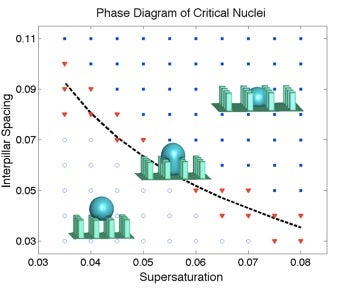Vapor condensation patterned with microstructures
REN Weiqing (Group Leader, Mathematics) () August 11, 201511 Aug 2015 Scientists in NUS have developed computational methods to explore how microstructures affect the condensation of vapor onto a surface.
Vapor condensation on solid surfaces plays a crucial role across a wide range of industrial applications, including self-cleaning, defrosting and anti-icing surfaces. Recent advances of nanotechnology have made possible the manipulation of the condensation process through the control of surface structures. Inherently water-repellent surfaces can be made much more water repellent by patterning them with micro- or nanoscale structures.
A team led by Prof REN Weiqing from the Department of Mathematics in NUS has systematically analyzed how microstructures on a hydrophobic surface affect the condensation of water vapor. To do this, they used a powerful computational technique known as the string method. The string method was developed in their previous work for the study of complex energy landscapes and barrier-crossing events.
They used the string method to investigate the effect of parameters such as the topography, the surface chemistry and the supersaturation on the condensation process. The critical nuclei and the activation barriers were computed. Two generic nucleation scenarios were obtained from the computation – one prefers the suspended state whereas the other prefers the impaled state (see Figure). By generating a phase diagram, the authors were able to determine the critical values of the geometrical parameters at which the configuration of the critical nucleus changes from the suspended state to the impaled state. These results provide insights into the effect of surface structure on condensation and a quantitative basis for designing surfaces optimized to either inhibit or enhance condensation in engineered systems.

A phase diagram of the critical nucleus on the plane of the supersaturation and the inter-pillar spacing. [Image credit: Ren WQ]
Reference
Li Y, Ren W. “Numerical study of vapor condensation on patterned hydrophobic surfaces using the string method.” Langmuir 30 (2014) 9567.


